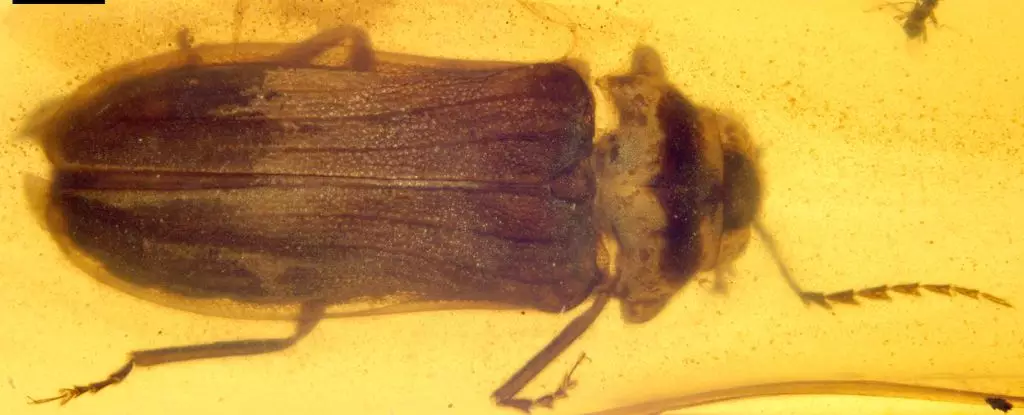As night blankets the warm summer sky, the enchanting spectacle of fireflies dances across the landscape, casting a magical glow that captures the attention of onlookers. These luminescent insects, which belong to a vast group of approximately 2,500 known species, are not merely spectacles of nature; they embody a complex evolutionary tale that continues to spark curiosity among scientists and nature enthusiasts alike. Their ability to emit light—a phenomenon known as bioluminescence—serves crucial purposes including mate attraction and predator deterrence. However, the journey of how these remarkable traits developed remains somewhat of a mystery.
Recent research led by Chenyang Cai from the Chinese Academy of Sciences has brought new insights into the historical timeline of fireflies through a groundbreaking find—an exceptionally preserved specimen encased in 99-million-year-old amber from Myanmar. This fossil, named Flammarionella hehaikuni, provides a tantalizing glimpse into the evolution of bioluminescence in insects, suggesting that the capability to glow has been a part of firefly biology for millions of years. Previously, a similar specimen, Protoluciola albertalleni, was identified, but what distinguishes F. hehaikuni is its unique lantern structure, hinting at the diversity and adaptability of firefly species even during the Mesozoic era.
Functional Significance of Bioluminescence
Understanding the evolutionary purpose of bioluminescence in fireflies invites probing questions. Initial theories posited that these glowing features primarily served as a means for fireflies to attract mates. The ephemeral light created by male fireflies as they signal to females adds a romantic and visual allure to summer evenings. Additionally, bioluminescence offers a practical defense mechanism; the luminescent substances may indicate the presence of toxic compounds known as lucibufagins, which help deter would-be predators. However, some researchers now suggest that bioluminescence may have developed independently of these toxins, leading to further discussions and investigations regarding the original benefits of this phenomenon in early firefly ancestors.
Cai and his team’s examination of F. hehaikuni uncovered fascinating anatomical details that could shed light on the ecological interactions of ancient fireflies. Descriptive analysis of its physical structure reveals a female belonging to the Luciolinae subfamily. Notably, its antennae contained ornate hair-like setae, an adaptation that enhances the sensory capabilities of the insect, allowing it to detect pheromones and interact with potential mates. This observation reinforces the idea that, despite the passage of millions of years, some aspects of firefly behavior and anatomy remain eerily familiar.
The intricacies of F. hehaikuni’s lantern, consisting of two prominent segments, present an opportunity for further exploration in comparative anatomy among other Mesozoic insects. By juxtaposing these features with extant fireflies, researchers can glean deeper insights into the evolutionary pathways that have shaped fireflies’ bioluminescence over time.
While the discovery of F. hehaikuni is monumental, it represents just the tip of the iceberg. The Kachin State amber deposits in Myanmar have proven to be fertile grounds for paleontological explorations, with a wealth of undiscovered fossilized insects still lying in wait. Excitingly, the prospect of uncovering more specimens holds the promise of unlocking further details about the evolutionary history of bioluminescence in fireflies and their relatives. Such findings may not only enrich our understanding of these captivating creatures but also contribute significantly to the field of evolutionary biology, illuminating the pathways through which complex traits have developed.
The ancient fireflies encased in amber stand as a testament to the enduring beauty of nature and the intricate web of life that has evolved over millions of years. As researchers continue to delve into the past, the stories these preserved specimens tell will undoubtedly outline the remarkable journey of fireflies, shedding light on how such stunning natural phenomena navigate the complex interplay of survival, reproduction, and evolution. The pursuit of knowledge regarding these luminous beetles will not only fascinate future generations but may also inspire new avenues of research—an endeavor as radiant as the fireflies themselves.


Leave a Reply